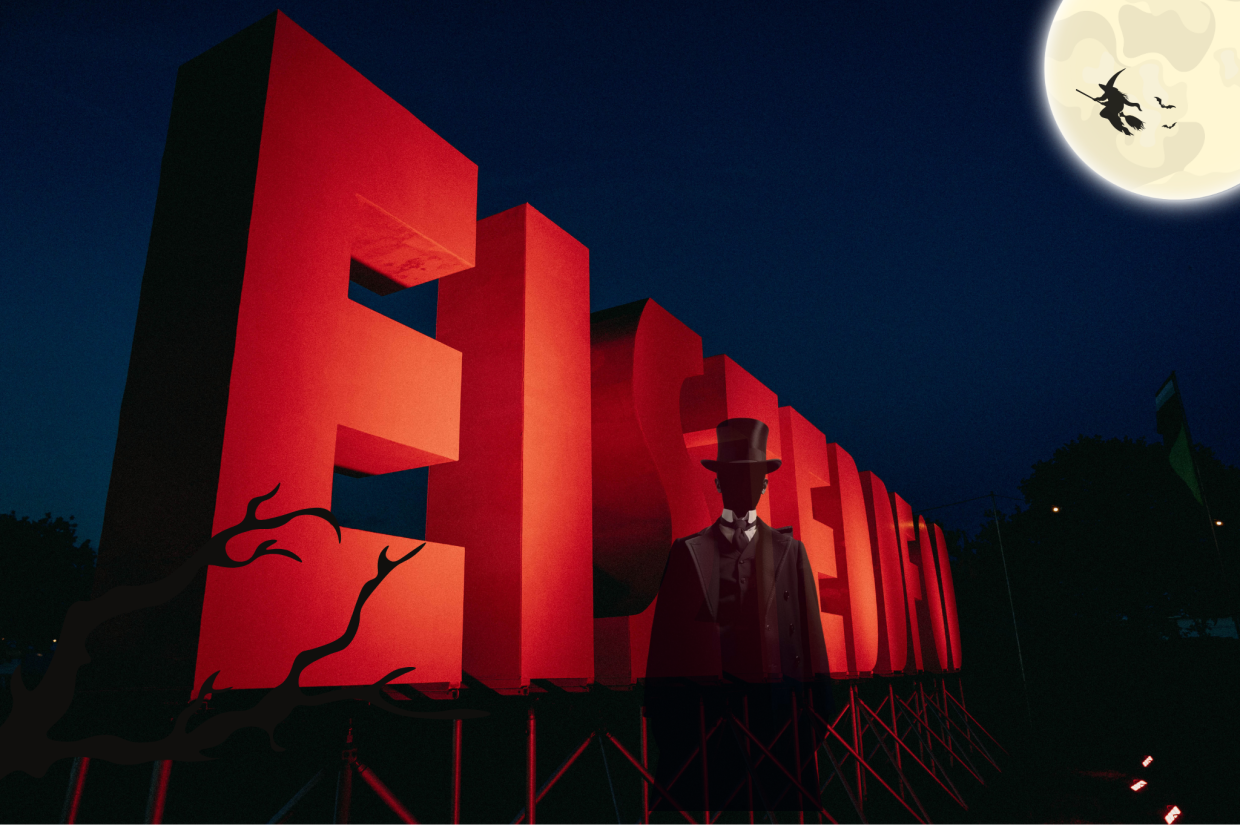The days are getting shorter, and the nights are getting colder which can only mean one thing – spooky season is upon us.
Here at the National Eisteddfod of Wales, we’re surrounded by centuries of Welsh culture, poetry, music and legend, so we’re no strangers to ghostly stories and strange occurrences. From ghostly sightings to haunting storms and mysterious disappearances, what better way to celebrate Halloween than by exploring some of the Eisteddfod’s spooky stories where Welsh tradition meets the supernatural.
The Mystery of the Disappearing Letters – Eisteddfod Genedlaethol Tregaron, 2022
It was the first Eisteddfod after Covid and the iconic, red Eisteddfod sign was back in business on the Maes. But overnight, something strange and mysterious happened. The letters E, F, O and D disappeared! Rumours began spreading like wildfire as the press, Eisteddfod attendees and even staff members wondered what had happened to the sign. Some even reported seeing shadowy figures near the site of the missing letters! Was it a prank? A ghost? Or could it even be a spirit of a bard from the past? Luckily, our technical team, led by the incredible Tony Thomas, created new letters for Eisteddfod Genedlaethol Llyn ac Eifionydd 2023.
2. The Bard of the Mist – Eisteddfod Tregaron, 1958
Have you ever spotted a tall man in a cloak and hat wandering near the Gorsedd Circle at dusk? It may be the Bardd y Niwl (The Bard of the Mist)! During the 1958 Eisteddfod in Tregaron, several attendees reported seeing a tall man dressed like a 19th-century bard, wandering near the Gorsedd Circle at dusk. A steward reportedly joked that “perhaps it was Taliesin come back to judge the poets.” Locals still mention ‘Bardd y Niwl when the evening mists roll over the site.

The Eisteddfod Chair and the Black Cloth – Eisteddfod Genedlaethol Wrecsam, 1876
From Hedd Wyn’s Yr Arwr to Mozart’s Requiem, the tale of masterpieces being written as death approaches is an occurrence often seen throughout history, such as in 1876’s Eisteddfod Wrecsam. Poet Taliesin of Eifion, Thomas Jones, sent off his entry to compete for the prestigious bardic Chair, but sadly died that very same evening. According to the story, his last words were, ‘Was the awdl delivered safely?’
Jones was never to discover that his awdl was victorious, and for the very first time in the history of the modern Eisteddfod, the Gorsedd placed the Chair at the front of the Pavilion and draped it in black cloth – a mourning shroud to honour Jones’ untimely death, and as a symbol of loss.

4. The ‘Merciless’ Storm – Eisteddfod Genedlaethol Aberdare, 1861
It was the first year of the ‘modern’ Eisteddfod, or the Eisteddfod as we know it today, and after an intense building period, the Maes was ready for the festival’s opening. But then, disaster struck as a violent storm approached. The strength of the storm tore down the Pavillion, destroying it. Fortunately, no one was injured, although the scene of debris was discouraging to all those who had worked so hard to prepare the Maes. But instead of worrying, the patriotic spirit of the poet, Alaw Goch, and the Eisteddfod committee managed to adapt the Market House as a replacement venue for the Pavillion.
The lesson of the storm? That the spirit and resilience of Welsh culture can never be crushed – no matter how great the storm!
The Whispering Stones of the Gorsedd Circle
With the Gorsedd steeped in such rich history, it’s no surprise that there’s more than one supernatural story circulating it. Following several of the earlier Eisteddfods, locals claimed that on the anniversary of the festival, you could hear whisperings Welsh poetry if you visited the site of the Maes at dawn. Was it the voices of past bards? Or just a trick of the wind?
Whether or not you believe these stories to be true, there’s no denying that the Eisteddfod is the home of a fair few mystery tales – you'd expect that of a tradition that dates back to 1176! Do you have a spooky Eisteddfod story that you want to share? Why not share it with us on social media - @eisteddfod on Instagram and ‘Eisteddfod Genedlaethol’ on Facebook.

